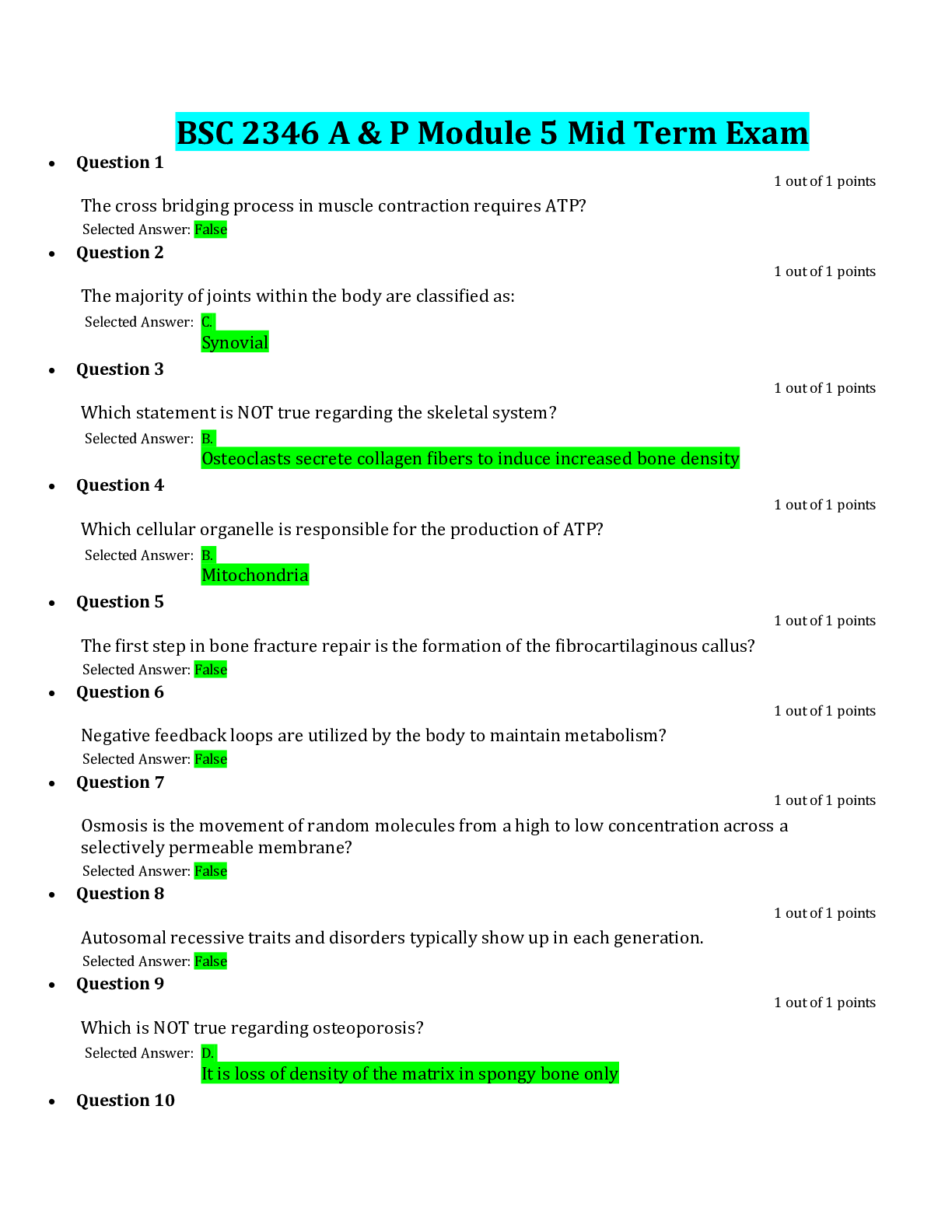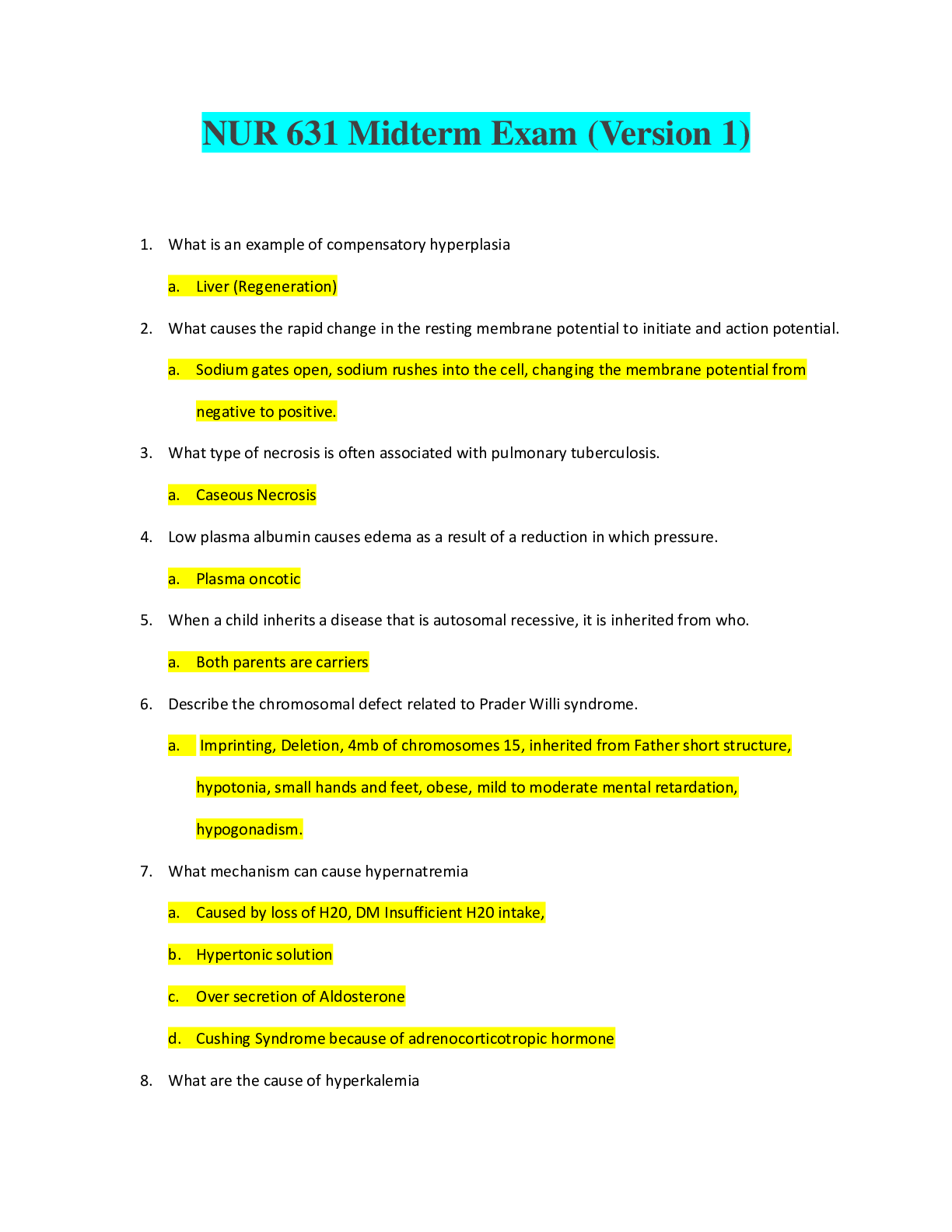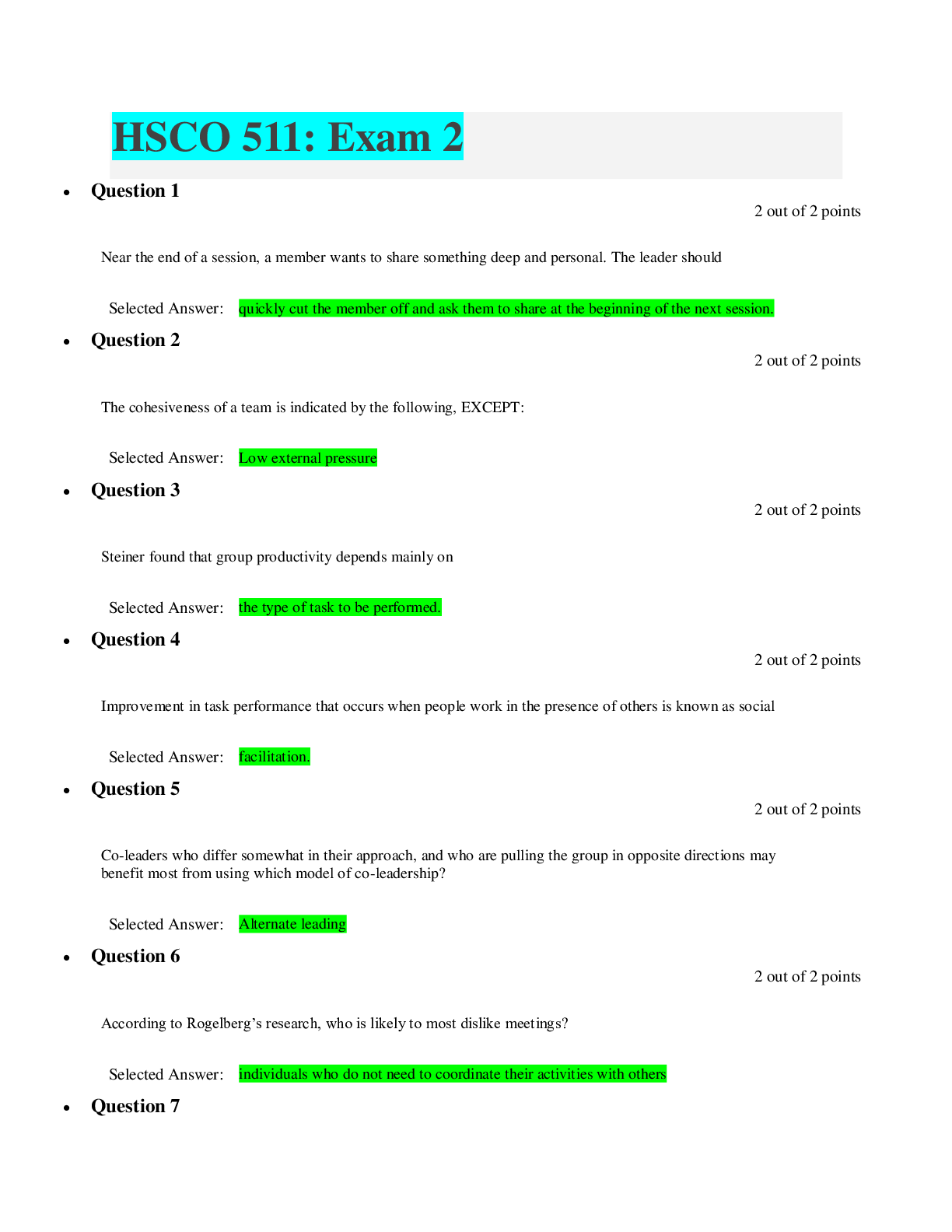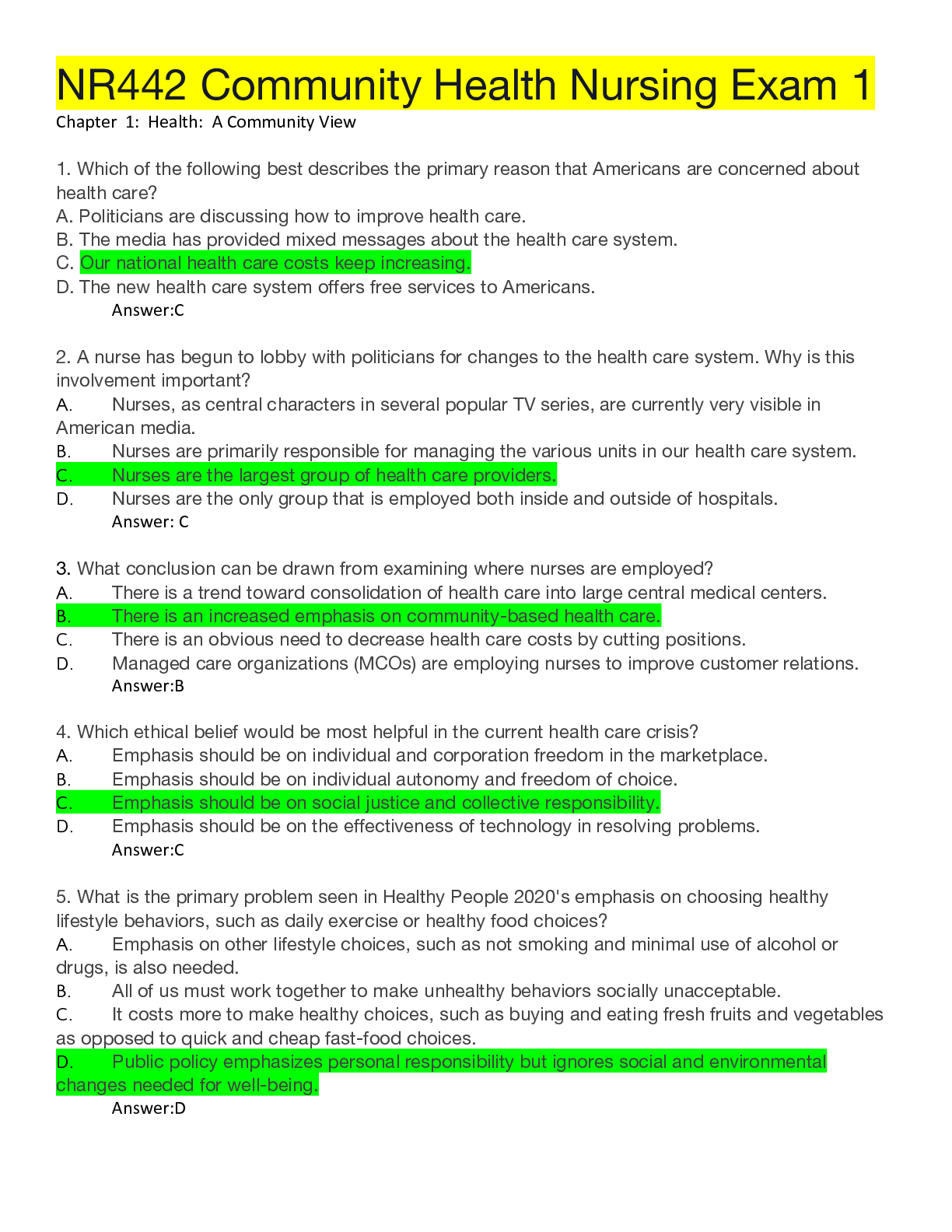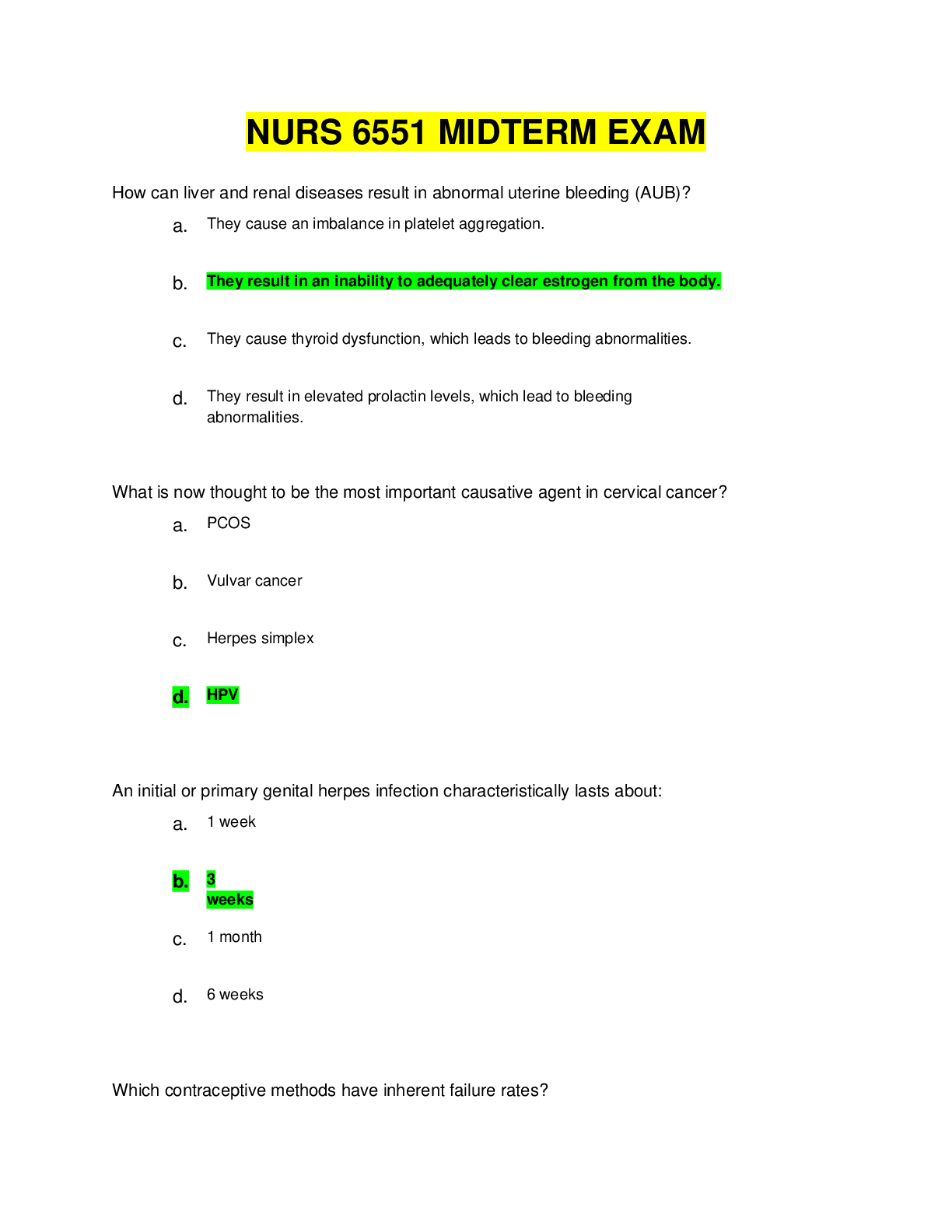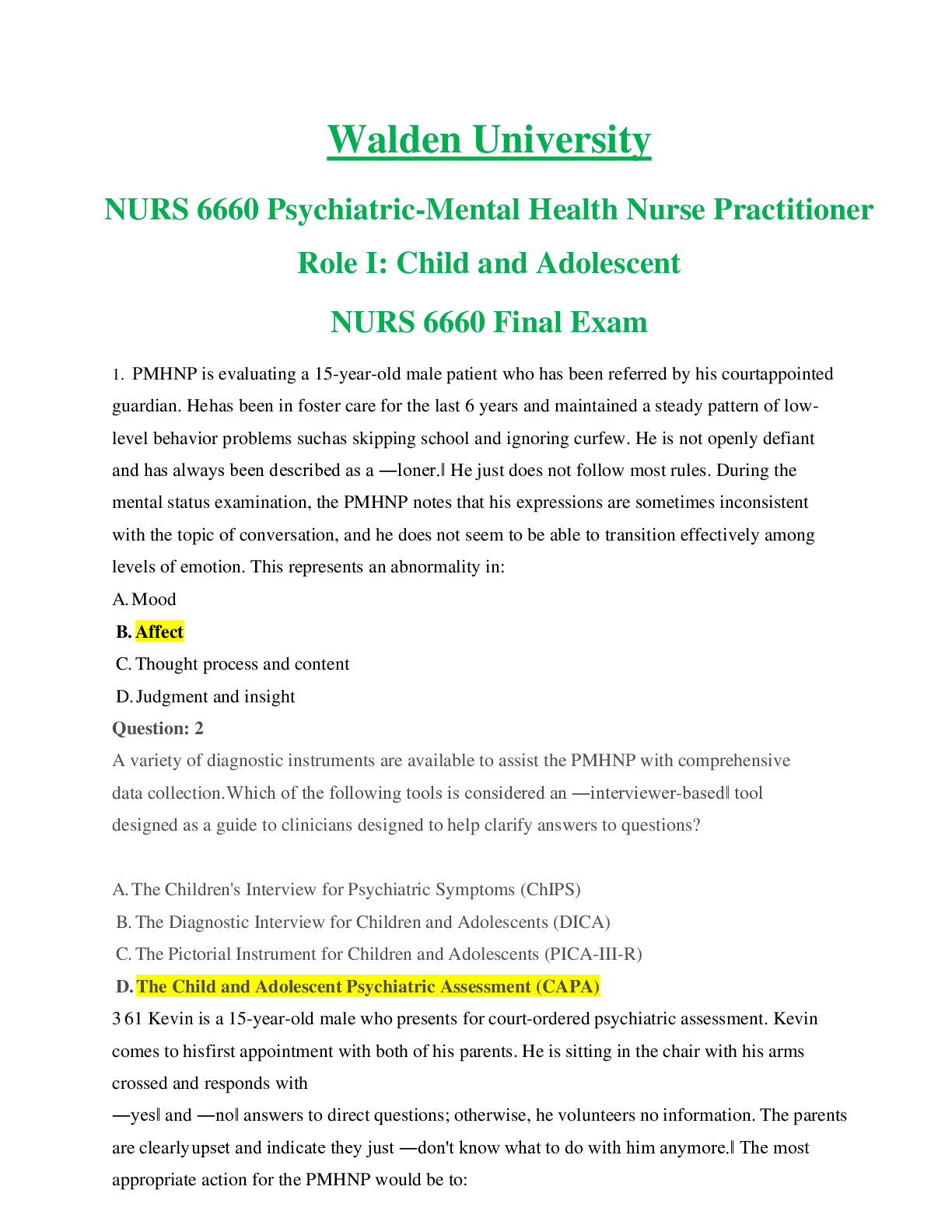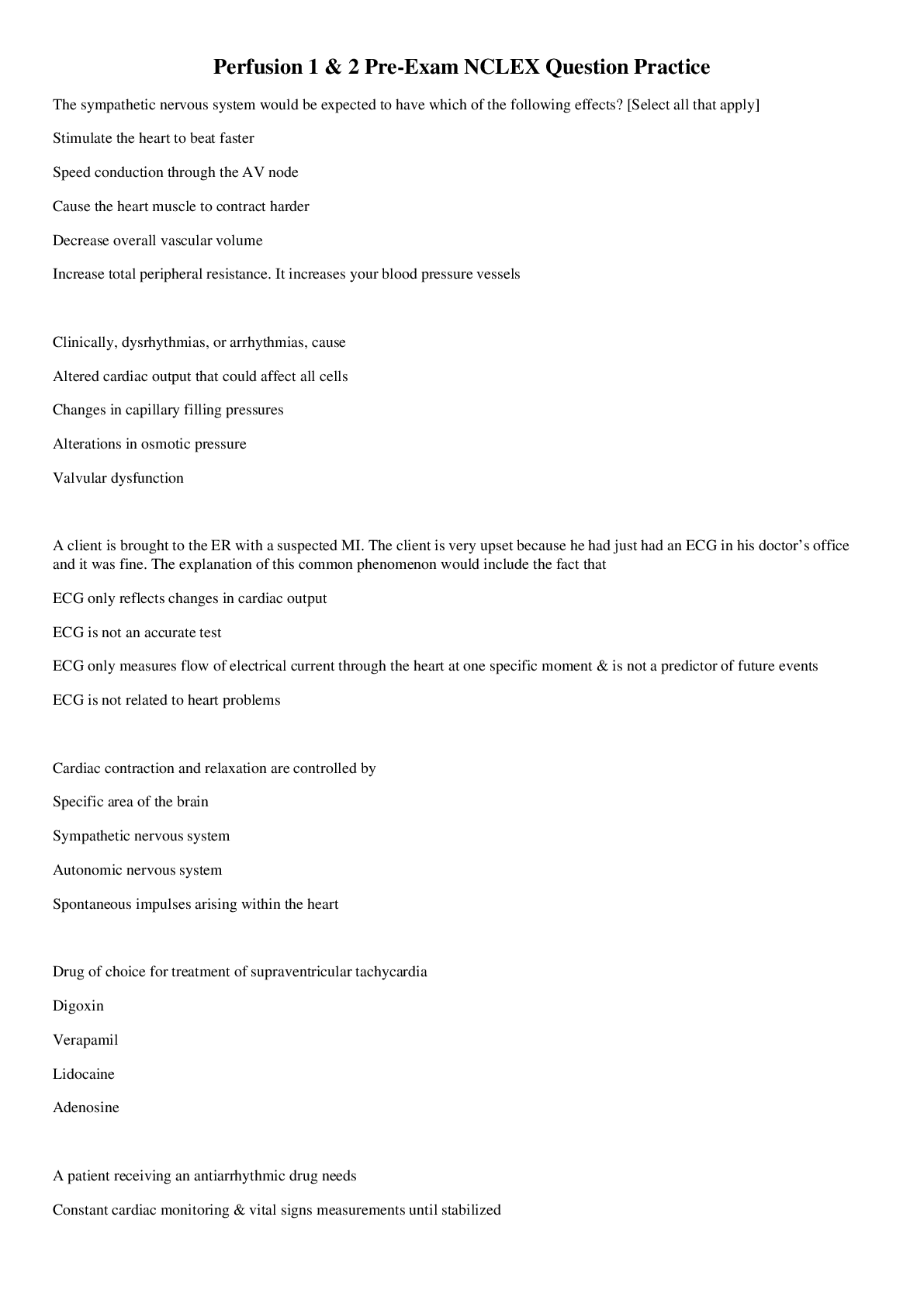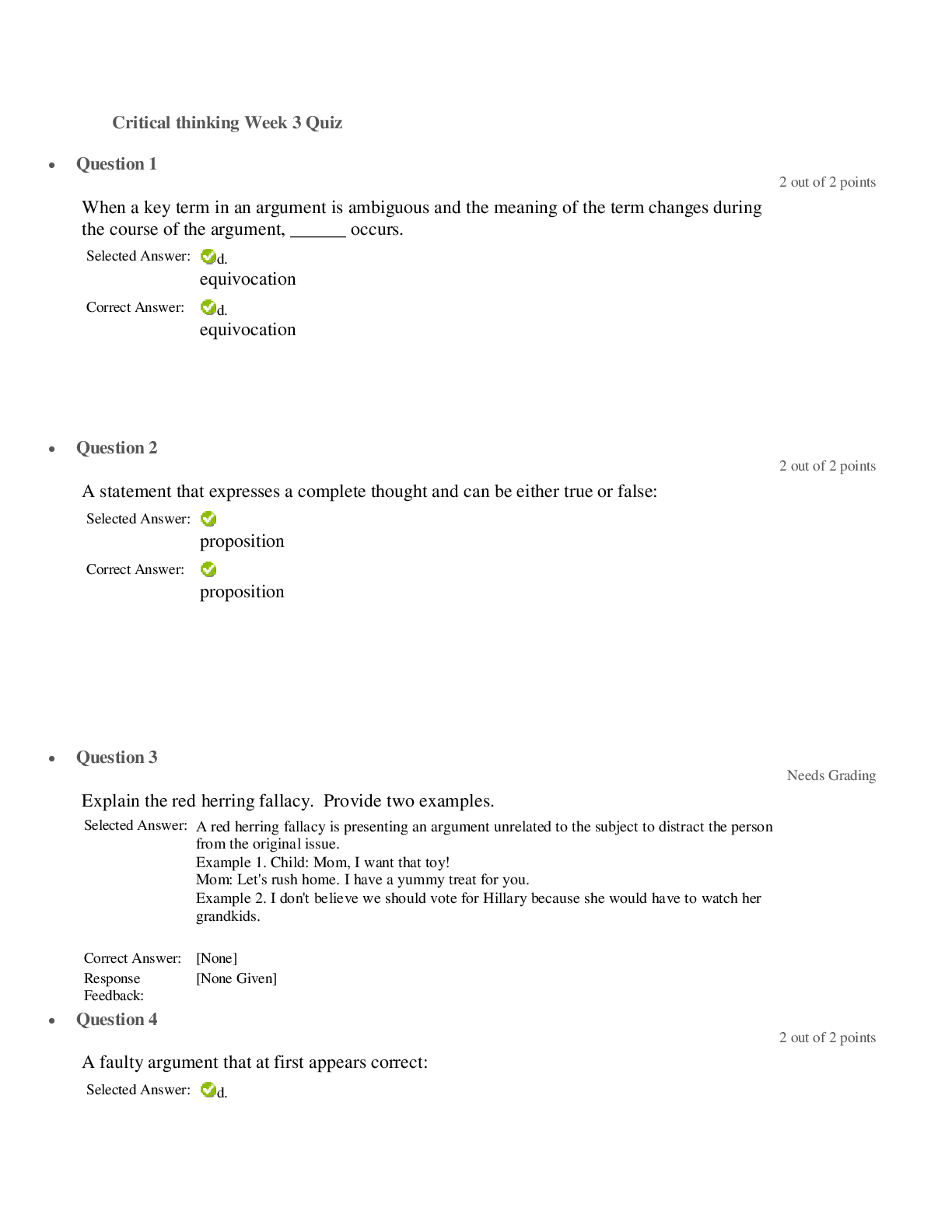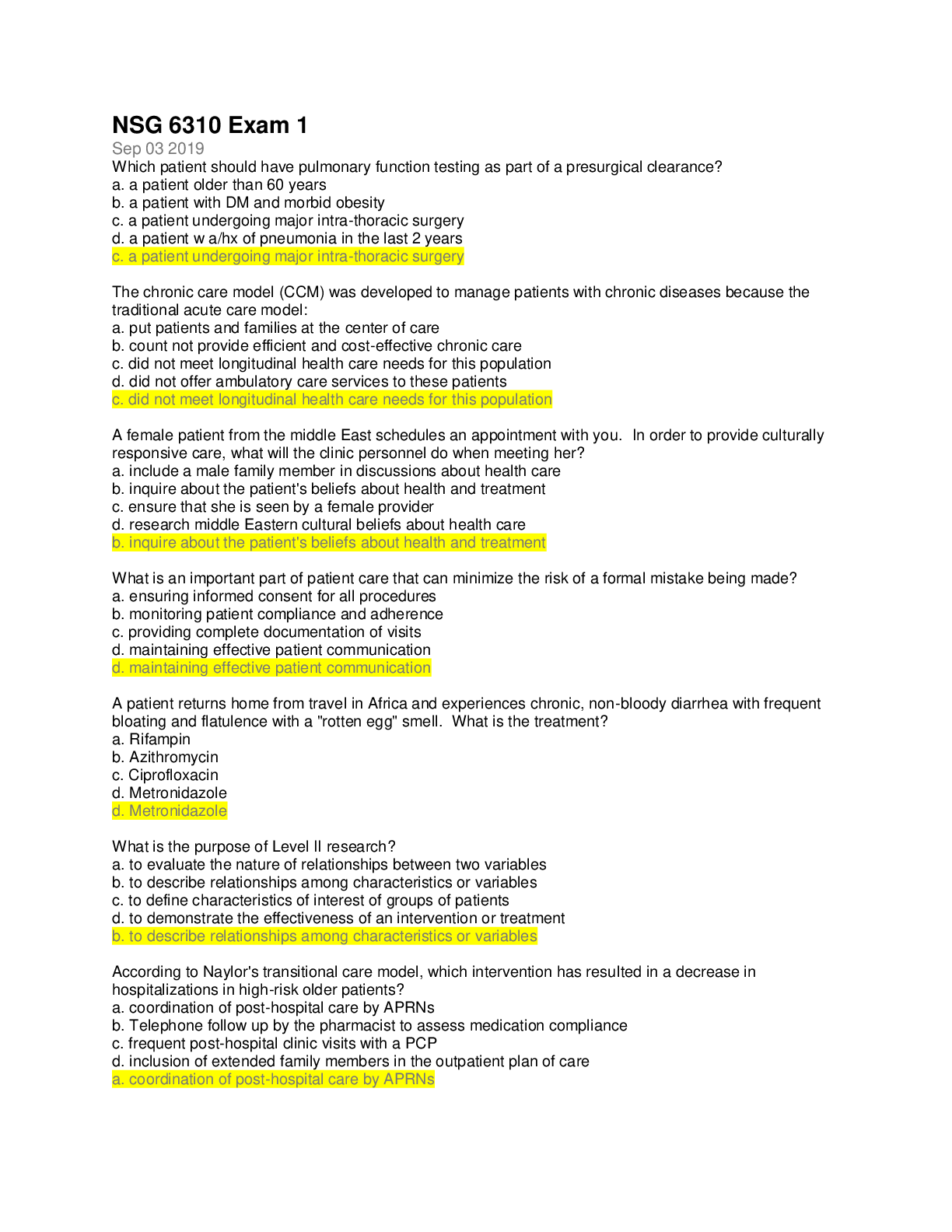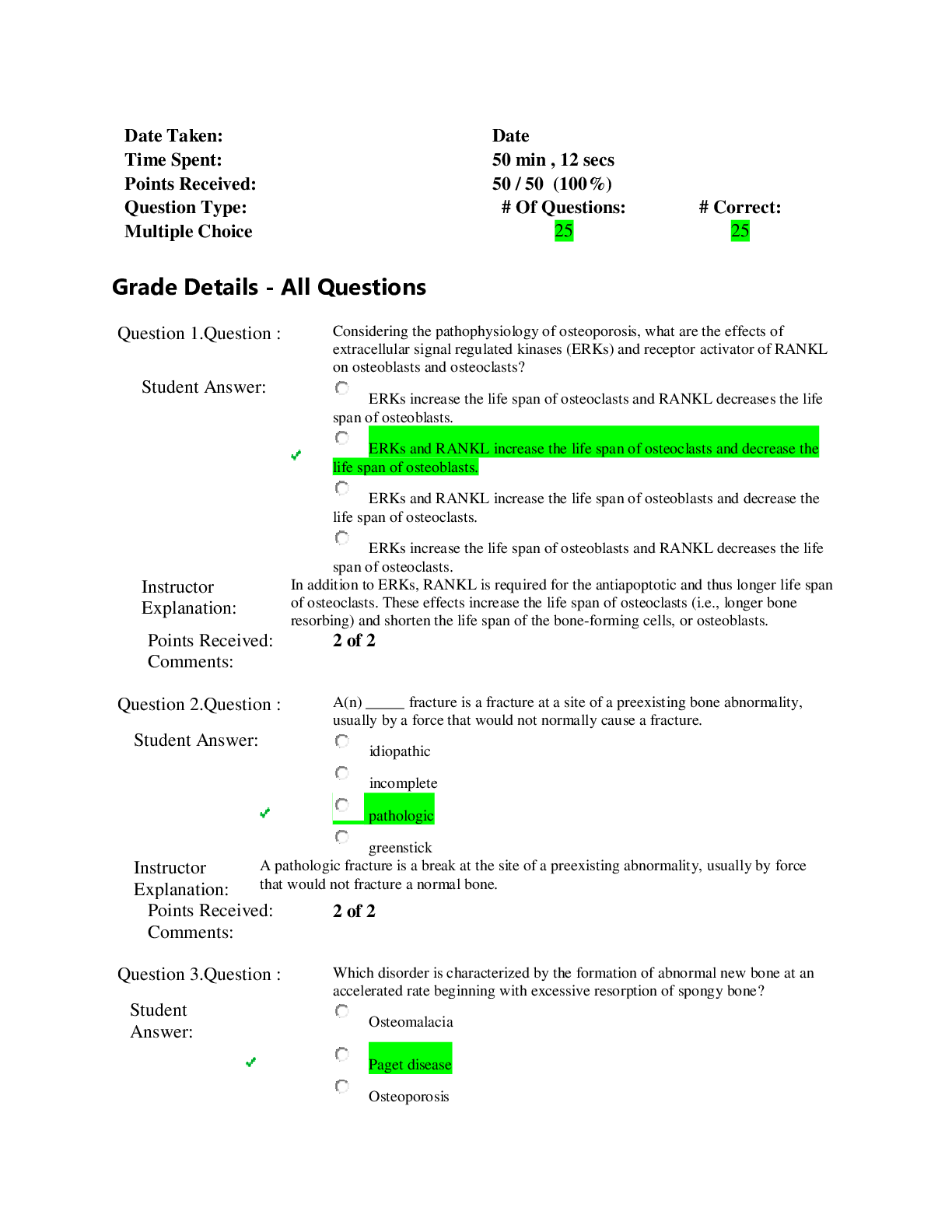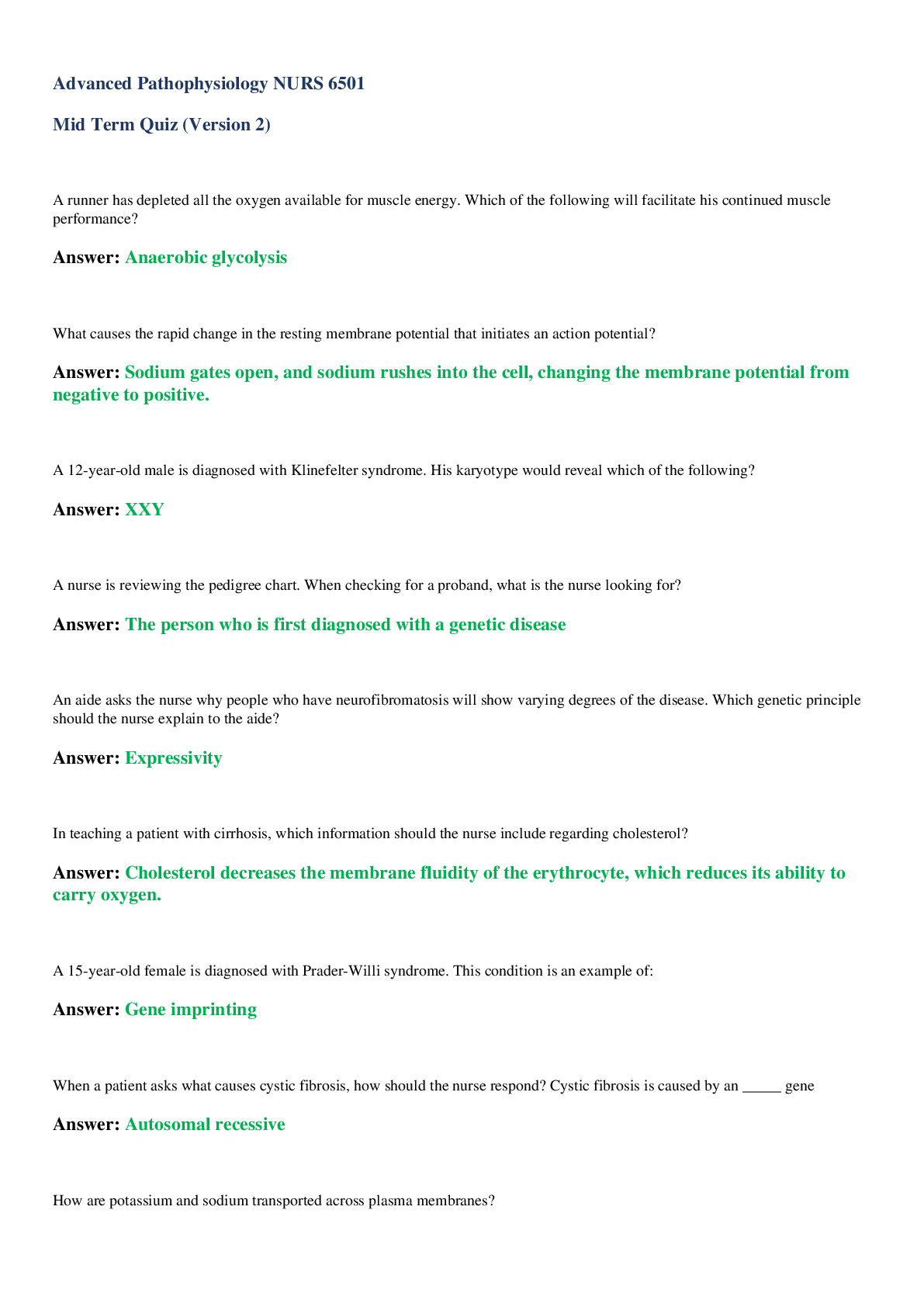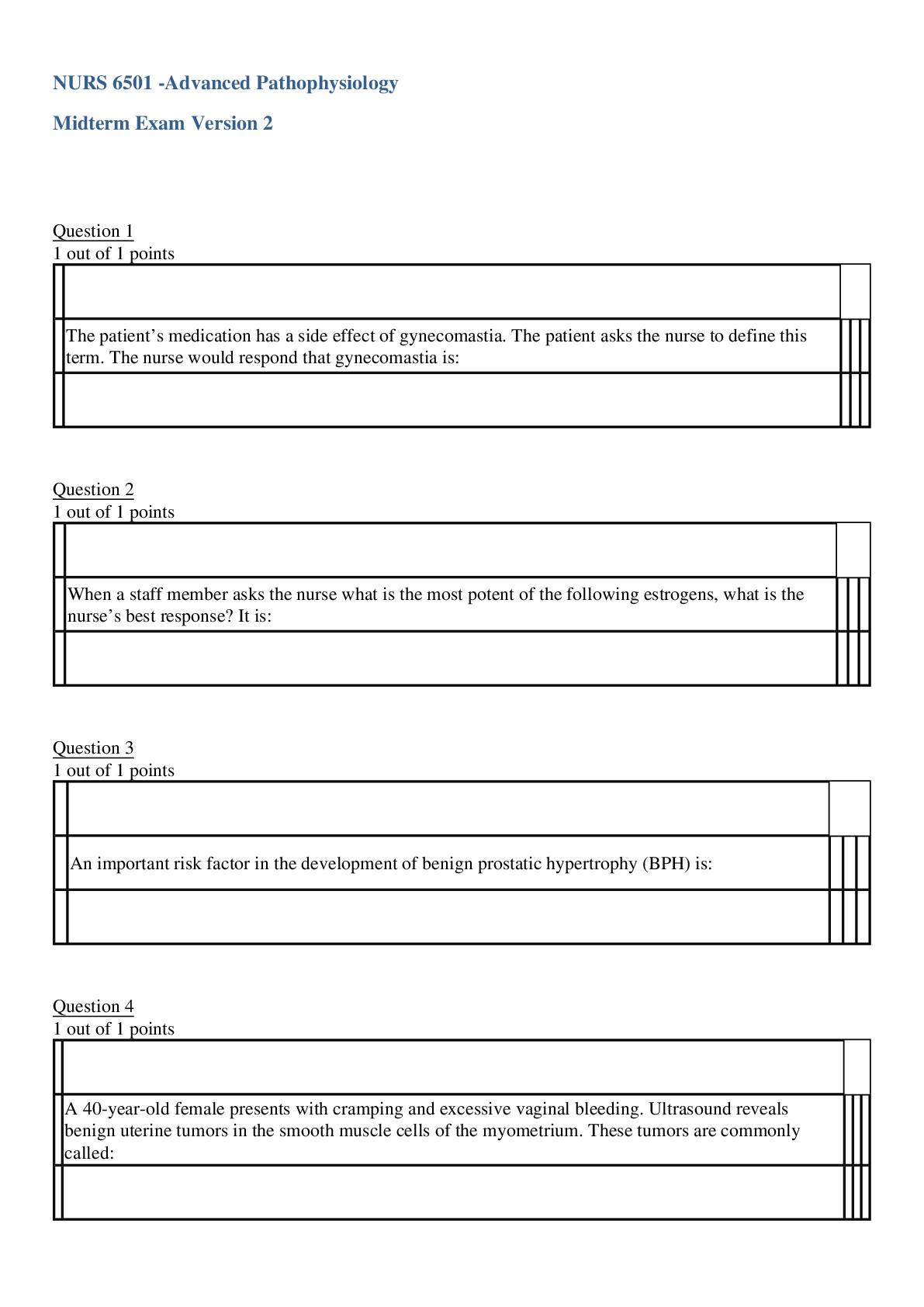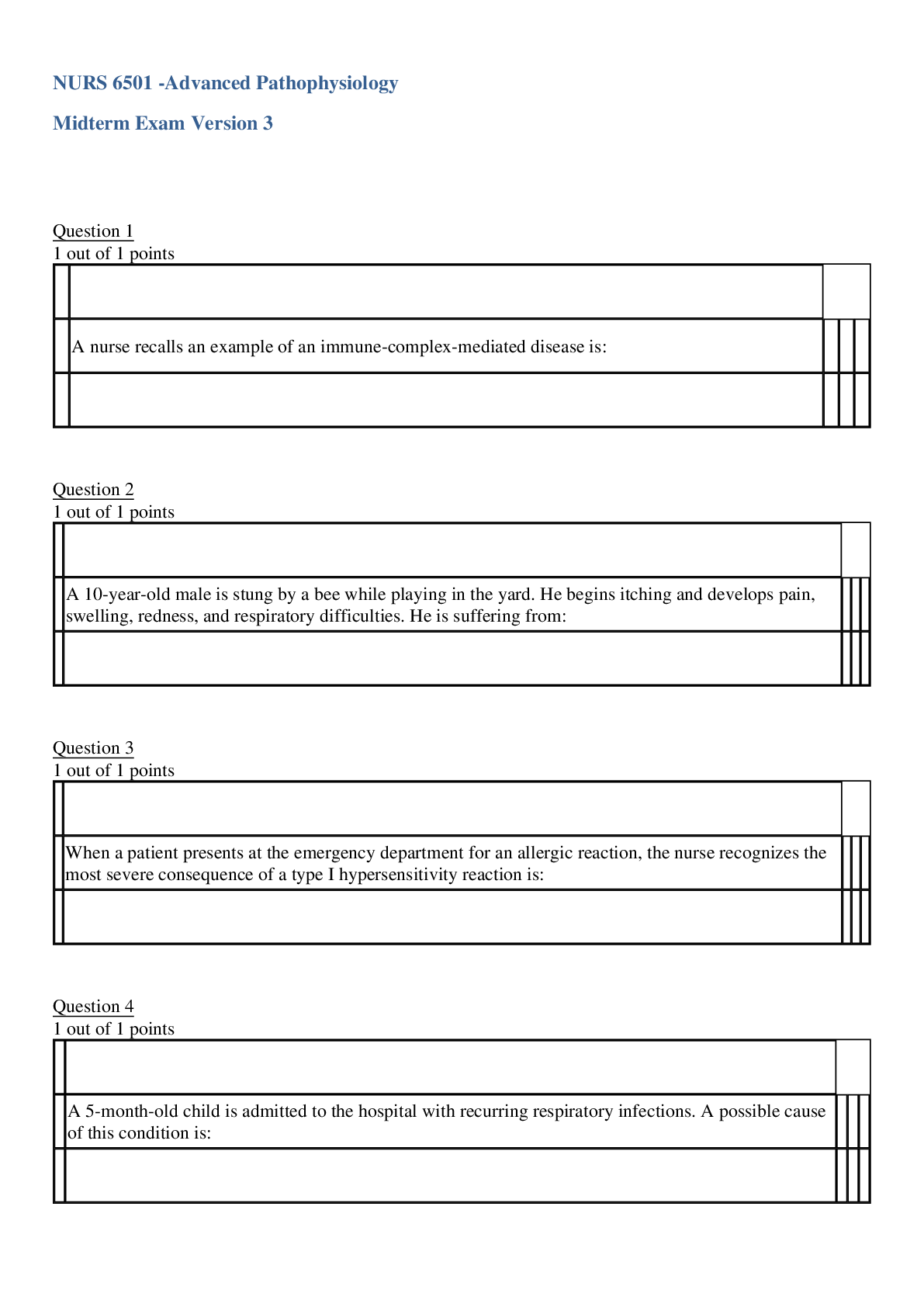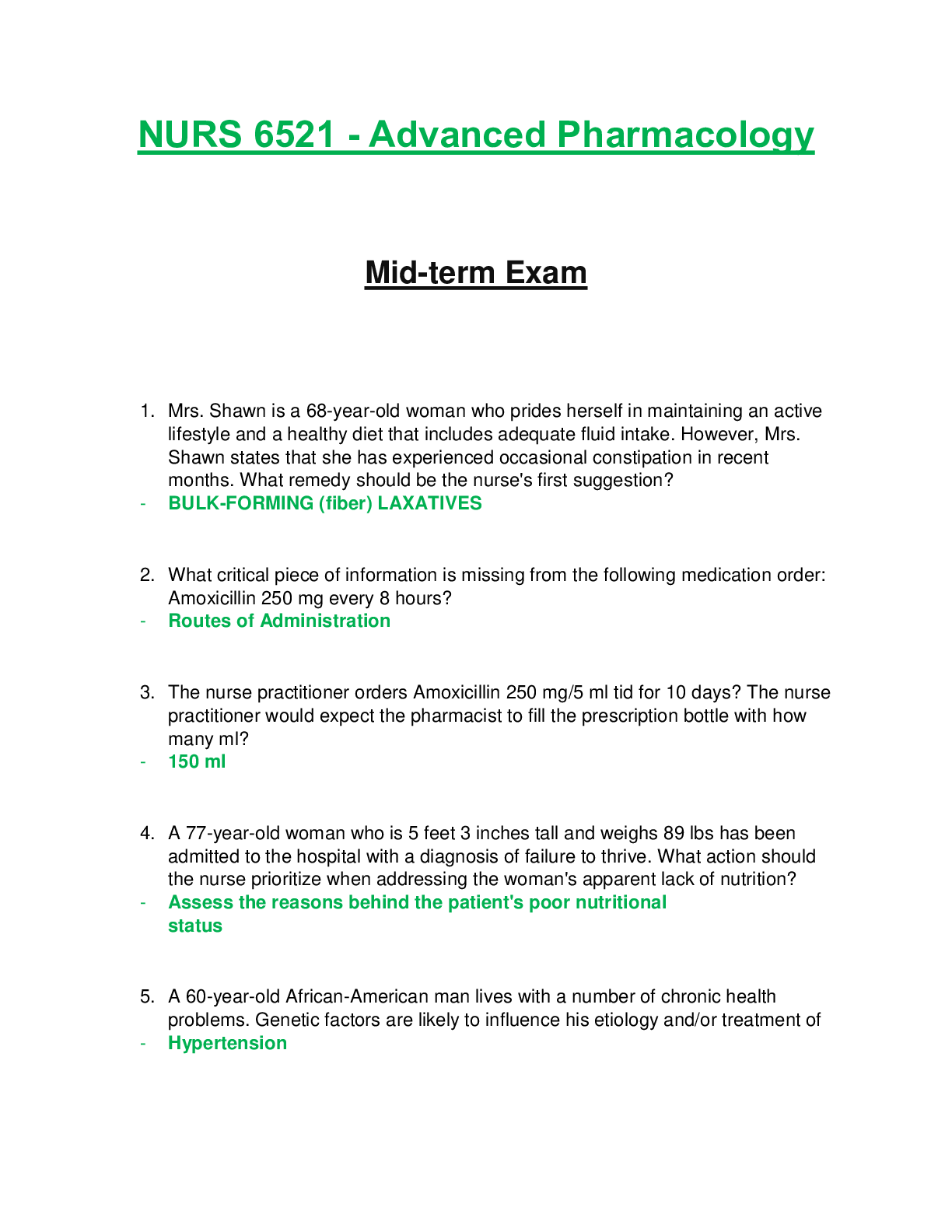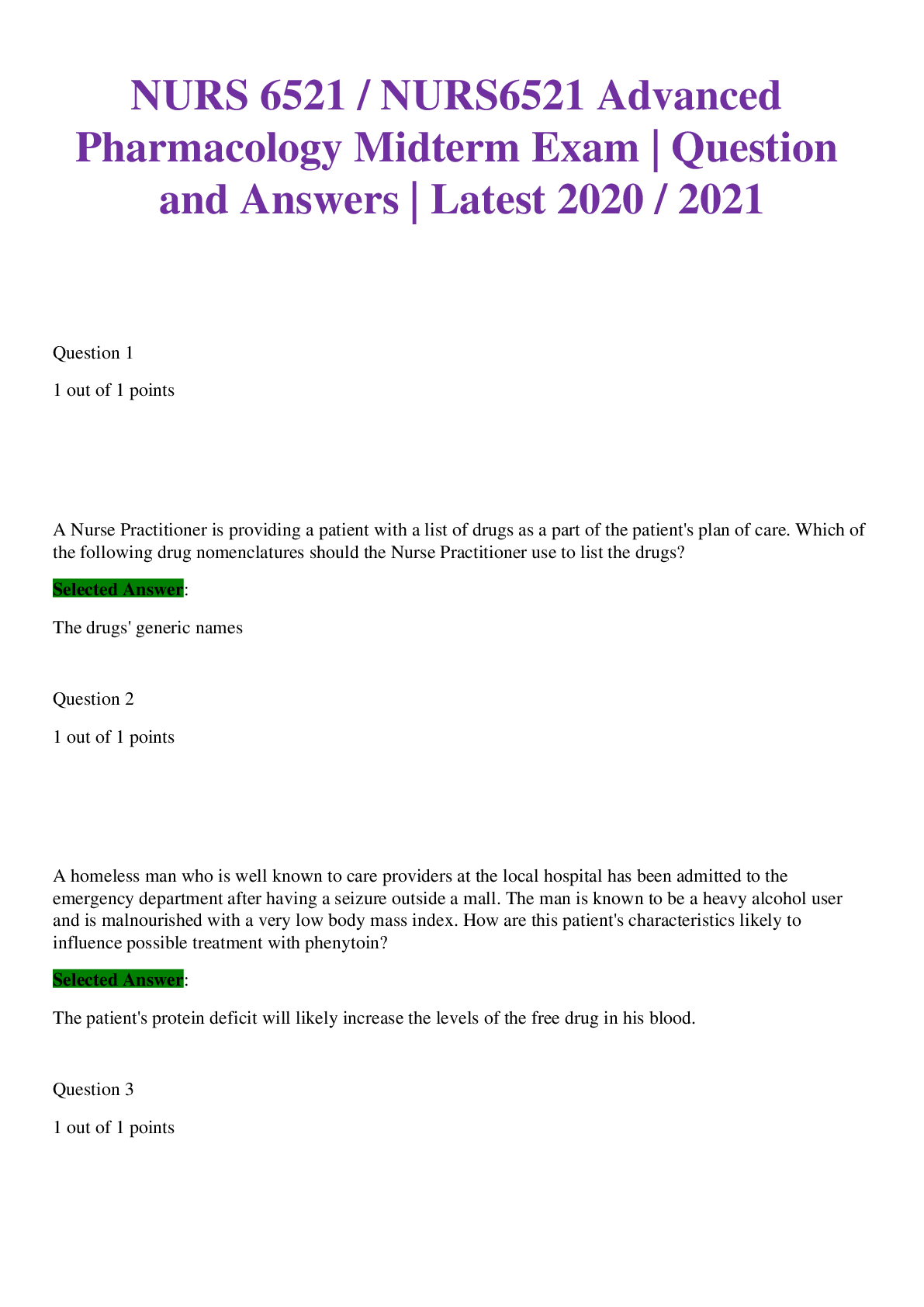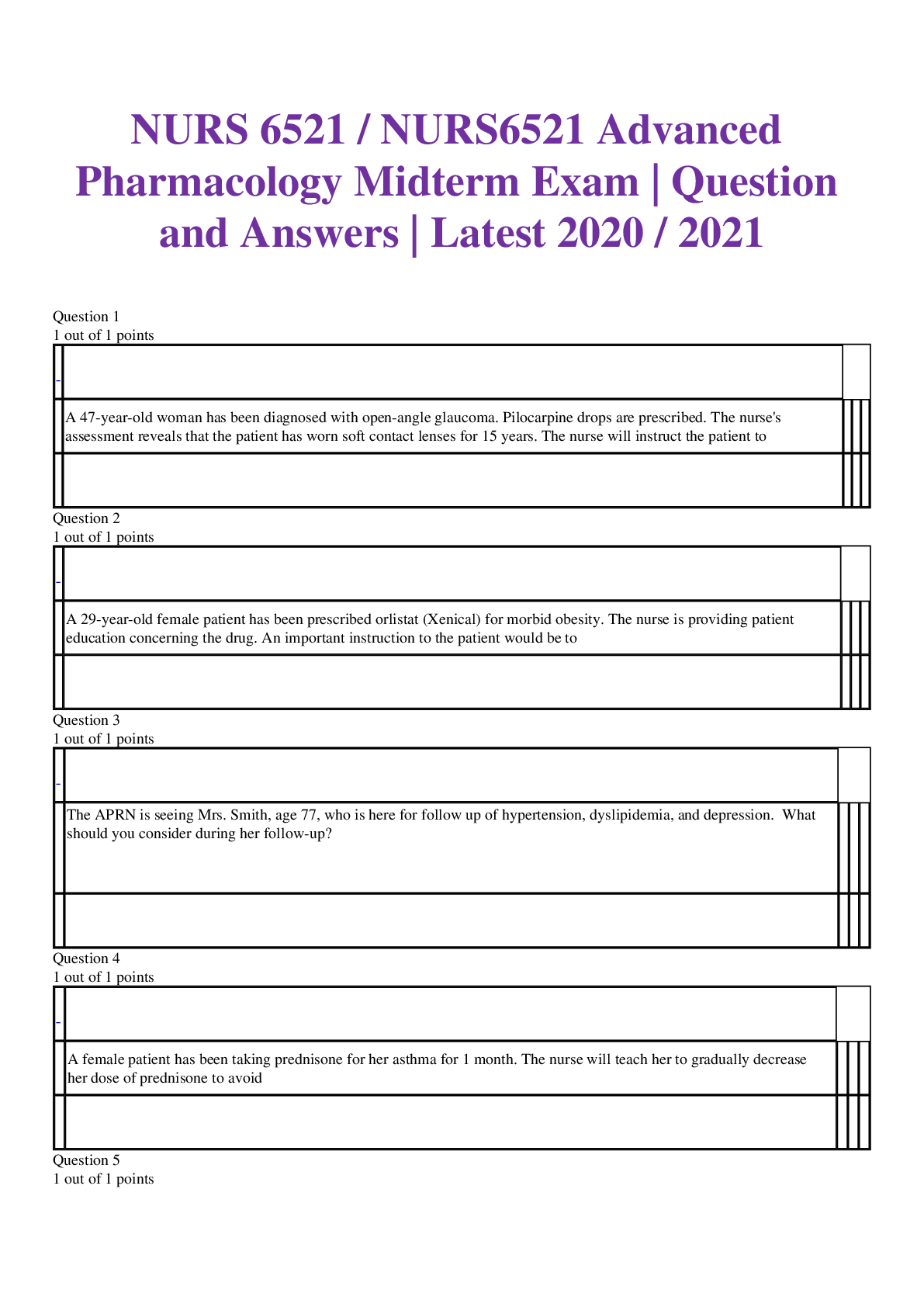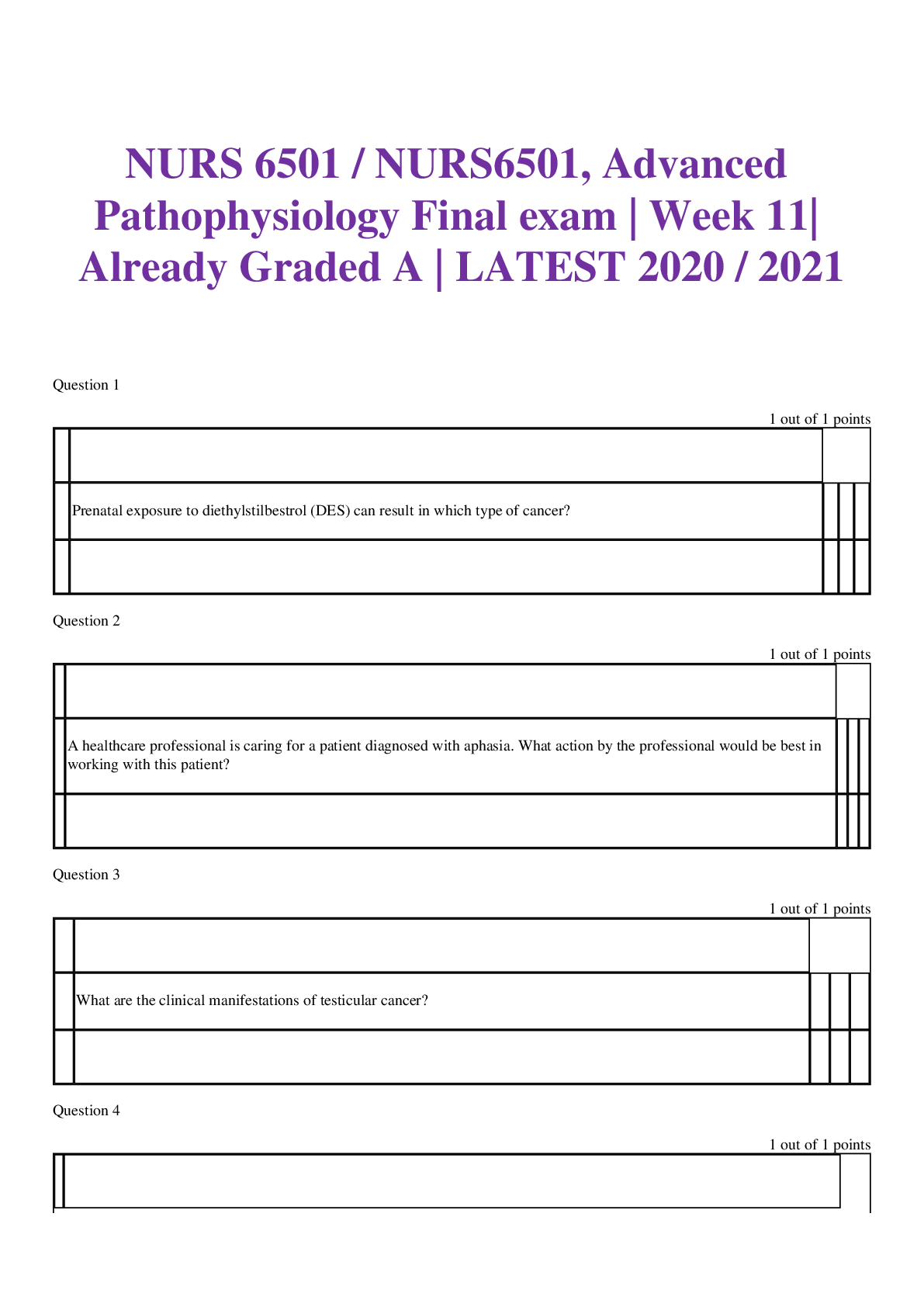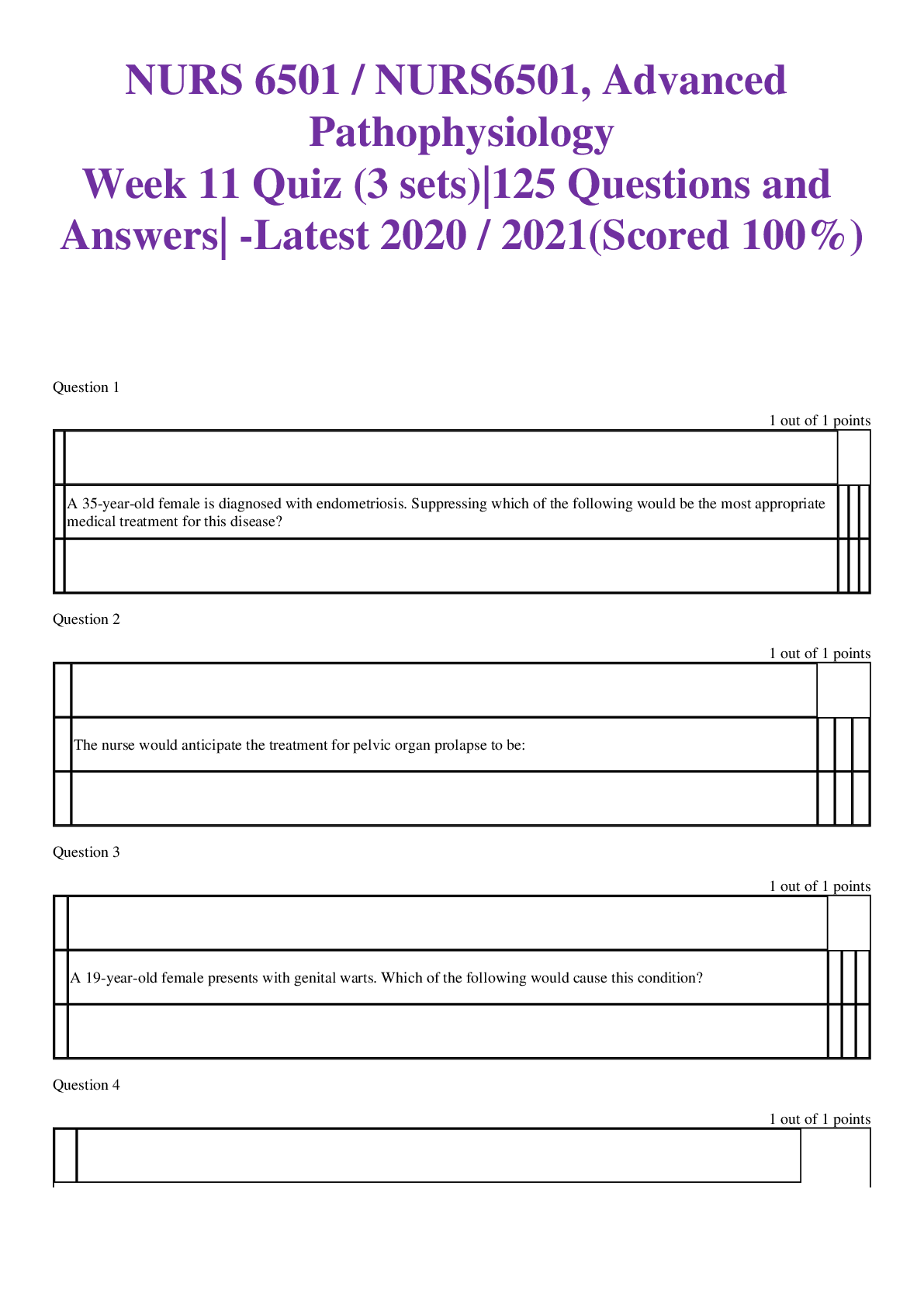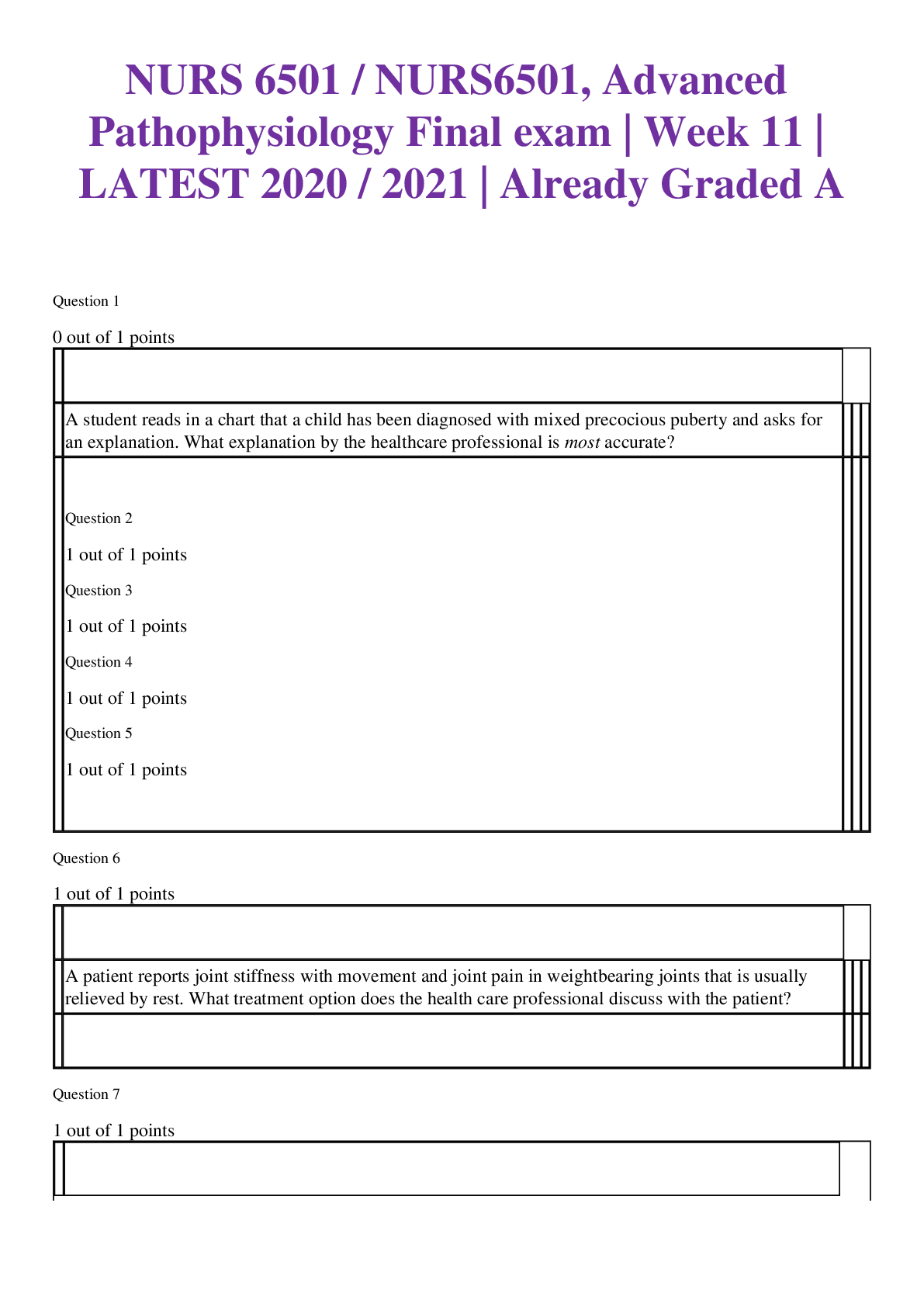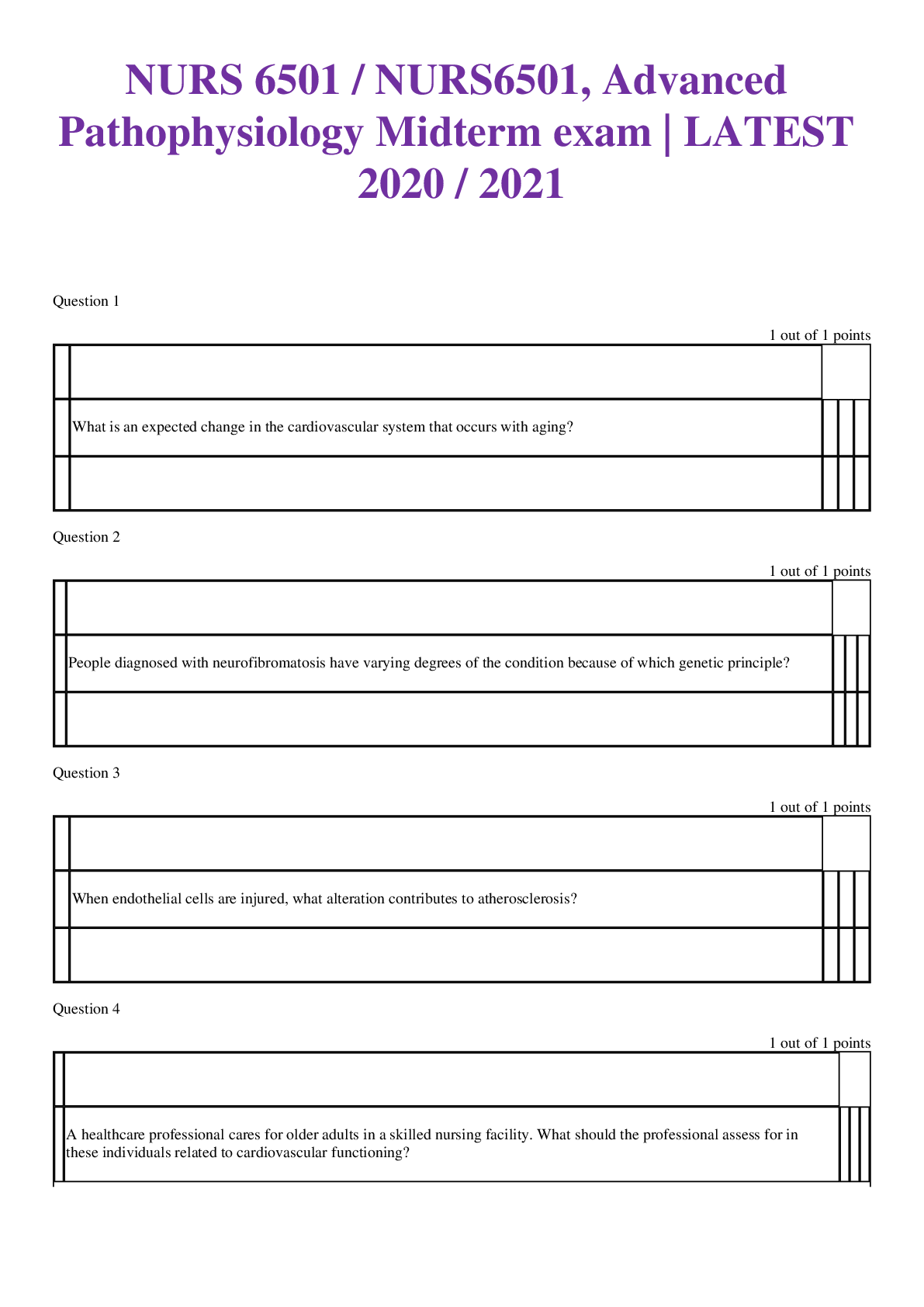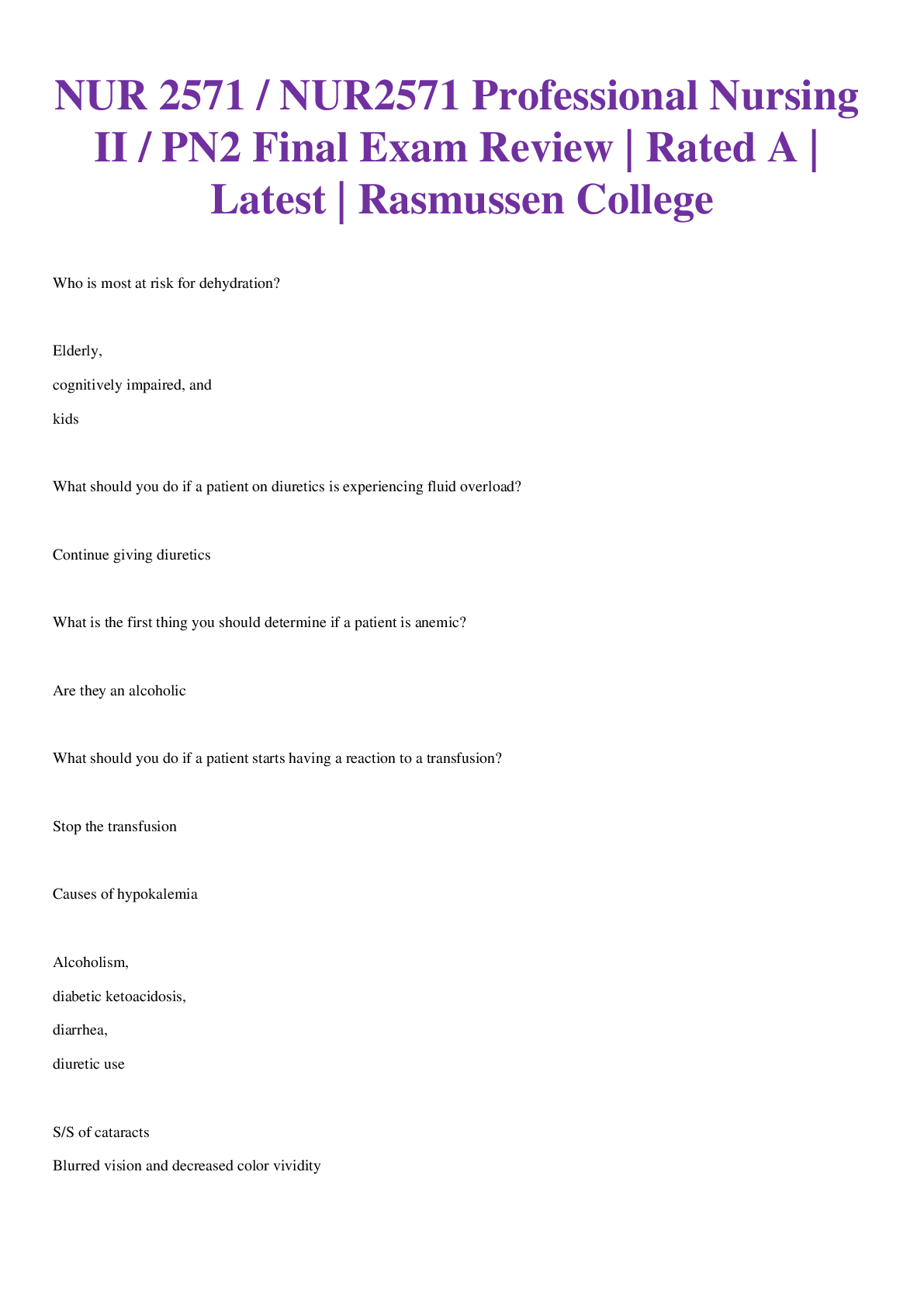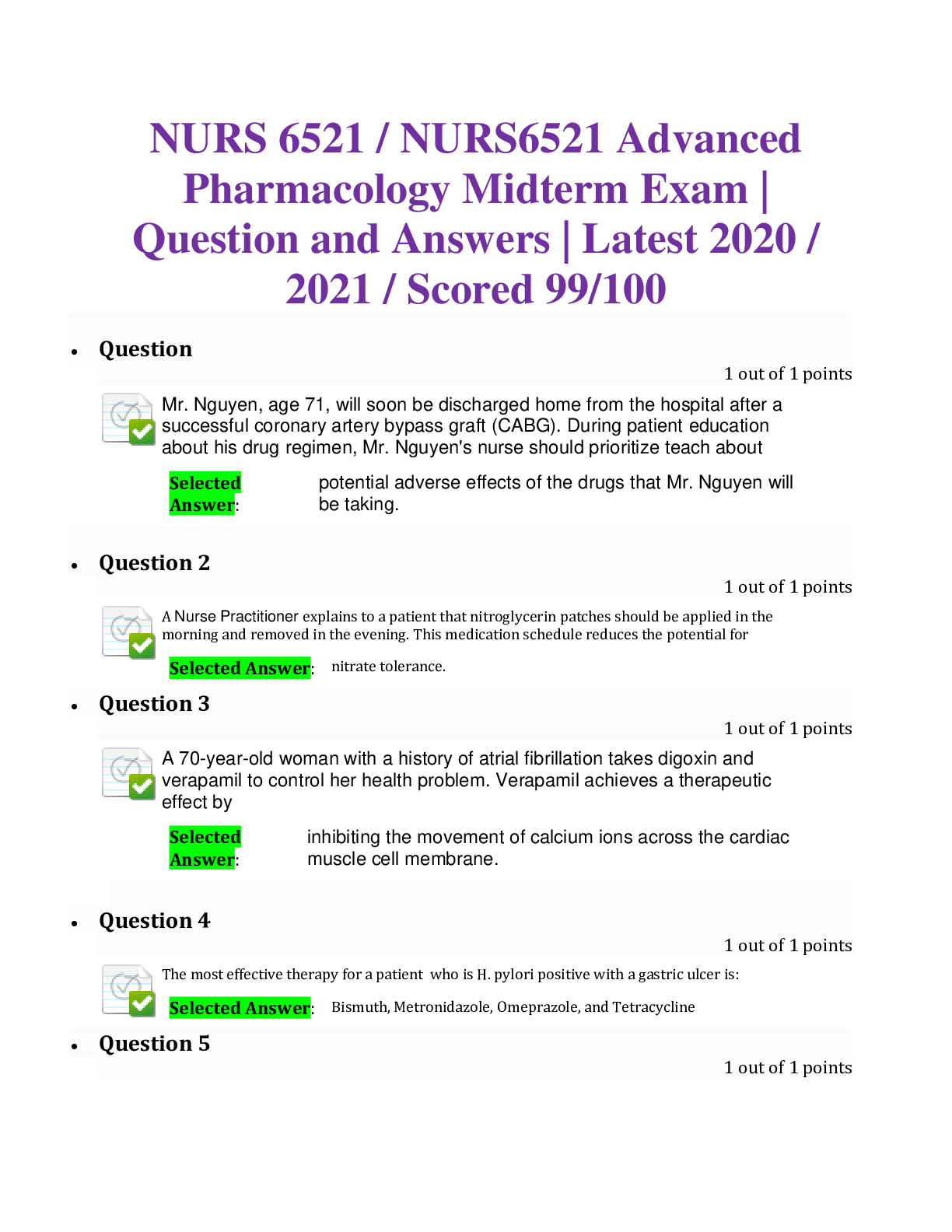*NURSING > EXAM > NUR2092 Exam 1 / NUR 2092 Exam 1 Latest complete Questions & Answers - Rasmussen College. (All)
NUR2092 Exam 1 / NUR 2092 Exam 1 Latest complete Questions & Answers - Rasmussen College.
Document Content and Description Below
NUR2092 Exam 1. • Question 1 The public’s concept of health has changed since the 1950s. Which of the following statements most accurately describes this change? Lifestyle, person... al habits, exercise, and nutrition are essential to health. Assessment of health is critical to identifying disease-causing pathogens. Accurate diagnosis and treatment by a physician are essential for all health care. An individual is considered healthy when signs and symptoms of disease have been eliminated. • Question 2 During an assessment, the nurse uses the CAGE test. The patient answers “yes” to two of the questions. What could this be indicating? The patient is an alcoholic. The patient is annoyed at the questions. The patient should be examined thoroughly for possible alcohol withdrawal symptoms. The nurse should suspect alcohol abuse and continue with a more thorough substance abuse assessment. • Question 3 What objective data would a nurse obtain during a physical examination? The client's radial and apical pulse The client's concern with their financial expenditures The client's complaints of numbness and tingling in their feet The client's reason for being hospitalized • Question 4 A female patient tells the nurse that she has had six pregnancies, with four live births at term and two spontaneous abortions. Her four children are still living. How would the nurse record this information? P-6, B-4, (S)Ab-2 Grav 6, Term 4, (S)Ab 2, Living 4 Patient has had four living babies. Patient has been pregnant six times. • Question 5 A 90-year-old patient tells the nurse that he can’t remember the names of the drugs he is taking or what they are for. An appropriate response would be: “Can you tell me what they look like?” “Don’t worry about it. You are only taking two.” “How long have you been taking each of the pills?” “Would you have your family bring in your medications?” • Question 6 A nurse is taking complete health histories on all the patients attending a wellness workshop. On the history form, one of the written question asks, “You don’t smoke, drink, or take drugs, do you?” This question is an example of: talking too much. using confrontation. using biased or leading questions. using blunt language to deal with distasteful topics. • Question 7 A patient tells the nurse that he is very nervous, that he is nauseated, and that he “feels hot.” This type of data would be: objective reflective subjective introspective • Question 8 Culture has four basic characteristics. Which statement correctly reflects one of these characteristics? Cultures are static and unchanging despite changes around them. Cultures are never specific, which makes them hard to identify. Culture is most clearly reflected in a person’s language and behavior. Culture adapts to specific environmental factors and available natural resources. • Question 9 A woman, Mrs. H., has just entered the emergency department after being battered by her husband. The nurse will need to get some information from her to begin treatment. What is the best choice for an opening with this patient? “Nancy, my name is Mrs. C.” “Hello, Mrs. H., my name is Mrs. C. It sure is cold today!” “Mrs. H., my name is Mrs. C. You sure look like you’re in pain, can I get you anything?” “Mrs. H., my name is Mrs. C. I’ll need to ask you a few questions about what happened.” • Question 10 Why is the concept of prevention essential in describing health? Disease can be prevented by treating the external environment. The majority of deaths among Americans under age 65 years are not preventable. Prevention places emphasis on the link between health and personal behavior. The means to prevention is through treatment provided by primary health care practitioners. • Question 11 Which of the following is an example of a folk healer? curandero botanica expressionist tourista • Question 12 Which of the following is an example of an 'open-ended question'? 'How have you been feeling today?' 'Did you try home remedies for your symptoms?' 'Did you drive yourself today?' 'Did you call your doctor?' • Question 13 An example of objective information obtained during the physical assessment includes the: patient’s history of allergies patient’s use of medications at home last menstrual period 1 month ago 2.5 cm scar present on the right lower forearm • Question 14 The first step in understanding the health care needs of another person is: identifying the meaning of health to the other person. understanding one’s own heritage-based cultural values, beliefs, attitudes, and practices relevant to health and illness. understanding how the health care delivery system works. being knowledgeable about the person’s social background. • Question 15 Which of the following statements is true regarding the assessment of mental status? Mental status assessment diagnoses specific psychiatric disorders. Mental disorders occur in response to everyday life stressors. Mental status functioning is inferred through assessment of an individual’s behaviors. Mental status can be assessed directly, just like other systems of the body (e.g., cardiac and breath sounds). • Question 16 During an interview, a parent of a hospitalized child is sitting in an open position. As the interviewer begins to discuss his son’s treatment, however, he suddenly crosses his arms against his chest and crosses his legs. This would suggest that the parent is: just changing positions. more comfortable in this position. tired and needs a break in the interview. uncomfortable talking about his son’s treatment. • Question 17 A female patient does not speak English well, and the nurse needs to choose an interpreter. Which of the following would be the most appropriate choice? A trained interpreter A male family member A female family member A volunteer college student from the foreign language studies department. • Question 18 Which of the following responses might the nurse expect during a functional assessment of a patient whose leg is in a cast? “I broke my right leg in a car accident 2 weeks ago.” “The pain is getting less, but I still need to take Tylenol.” “I check the color of my toes every evening just like I was taught.” “I’m able to transfer myself from the wheelchair to the bed without help.” • Question 19 The nurse is assessing mental status in children. Which of the following statements is true? All aspects of mental status in children are interrelated. Children are highly labile and unstable until the age of 2 years. Children’s mental status is largely a function of their parents’ level of functioning until the age of 7 years. Children’s mental status is impossible to assess until the child develops the ability to concentrate. • Question 20 When observing a patient’s verbal and nonverbal communication, the nurse notices a discrepancy. Which statement is true regarding this situation? The nurse should ask someone who knows the patient well to help interpret this discrepancy. The nurse should focus on the patient’s verbal message and try to ignore the nonverbal behaviors. The nurse should try to integrate the verbal and nonverbal messages and then interpret them as an “average.” The nurse should focus on the patient’s nonverbal behaviors because these are often more reflective of a patient’s true feelings. • Question 21 Symptoms, such as pain, are often influenced by a person’s cultural heritage. Which of the following is a true statement in regard to pain? Nurses’ attitudes toward their patients’ pain are unrelated to their own experiences with pain. The ethnic background of a patient is important in a nurse’s assessment of that patient’s pain. A nurse’s area of clinical practice is most likely to determine his or her assessment of a patient’s pain. A nurse’s years of clinical experience and current position are a strong indicator of his or her response to patient pain. • Question 22 Which statement is an appropriate component of one’s spirituality? Belief in the worship of God or gods Attendance at a specific church A personal effort to find purpose and meaning in life Closely tied to one’s ethnic background • Question 23 In response to a question regarding use of alcohol, a patient asks the nurse why the nurse needs to know. What is the reason for needing this information? This is necessary to determine the patient’s reliability. Alcohol can interact with all medications and make some diseases worse. The nurse needs to be able to teach the patient about the dangers of alcohol use. It’s not really necessary to have this information unless there is an obvious drinking problem. • Question 24 The nurse is performing a functional assessment on an 82-year-old patient with a recent stroke. Which of the following questions would be most important to ask? “Do you wear glasses?” “Are you able to dress yourself?” “Do you have any thyroid problems?” “How many times a day do you have a bowel movement?” • Question 25 A 42-year-old Asian patient is being seen at the clinic for an initial examination. The nurse knows that it is important to include cultural information in his health assessment to: identify the cause of his illness make accurate disease diagnoses. provide cultural health rights for the individual provide culturally sensitive and appropriate care. • Question 26 Which data would not be included in a client's health history? Laboratory tests Physical Assessment Nutritional assessment Family Medical History • Question 27 Which statement is correct regarding the development of one’s culture? Culture is genetically determined on the basis of racial background. Culture is learned through language acquisition and socialization. Culture is a nonspecific phenomenon and is adaptive but unnecessary. Culture is biologically determined on the basis of physical characteristics. • Question 28 Which of the following is the best definition of spirituality? A personal search to discover a supreme being An organized system of beliefs concerning the cause, nature, and purpose of the universe A belief that each person exists forever in some form, such as a belief in reincarnation or the afterlife That which arises out of each person’s unique life experience and his or her personal effort to find purpose in life • Question 29 Which of the following examples would be a hallucination? A man believes that his dead wife is talking to him. A woman hears the doorbell ring and goes to answer it, but no one is there. A child sees a man standing in his closet. When the lights are turned on it is only a dry cleaning bag. A man believes that the dog has curled up on the bed, but when he gets closer he sees that it is a blanket. • Question 30 When the nurse is evaluating the reliability of a patient’s responses, which of the following would be a correct statement? The patient has a history of drug abuse and therefore is not reliable. The patient provided consistent information and therefore is reliable. The patient smiled throughout interview and therefore is assumed reliable. The patient would not answer questions concerning stress and therefore is not reliable. • Question 31 The nurse is assessing a new patient who has recently immigrated to the United States. Which question is appropriate to add to the health history? “Why did you come to the United States?” “When did you come to the United States, and from what country?” “What made you leave your native country?” “Are you planning to return to your home?” • Question 32 Many individuals embrace the hot/cold theory of health illness. Which of the following best describes the basic tenets of this theory? The causation of illness is based on supernatural forces that influence the humors of the body. Herbs and medicines are classified on their physical characteristics of hot and cold and the humors of the body. The four humors of the body consist of blood, yellow bile, spiritual connectedness, and social aspects of the individual. The treatment of disease consists of adding or subtracting cold, heat, dryness, or wetness to restore the balance of the humors of the body. • Question 33 Which data do nurses document under the category of past health history? Chronic diseases Present illness Allergies to Medications Name and date of birth • Question 34 During an interview, the nurse notes that the patient gets up several times to wash her hands even though they are not dirty. This is an example of: social phobia. compulsive disorder. generalized anxiety disorder. posttraumatic stress disorder • Question 35 Which of the following is not a barrier to communication? clarification giving advice failure to listen judgmental statements • Question 36 Which of the following should a nurse document in the history component of a health assessment? Smoking Habits Vital Signs Facial symmetry Respiratory assessment • Question 37 The following statement could be found at which phase of the interview? “Mr. S., I would like to ask you some questions about your health and your usual daily activities so that we can better plan your stay here.” During the summary Closing the interview During the body of the interview Opening/introducing the interview • Question 38 When does the health assessment begin? When the nurse initially meets the client When the client tells the nurse their name When the nurse asks the client the first health-related question When the client consents to have a health assessment • Question 39 The largest and fasting growing population in the United States is: Hispanics Blacks Asians American Indians • Question 40 Which of the following is an example of a symptom? Chest pain Clammy skin Serum potassium level 4.2 mEq/L A temperature of 100 degrees F • Question 41 "During an interview with your client, she is very talkative and is sharing much information which is not pertinent to the reason for her admission to the hospital. Which action by you would improve your data collection in this particular situation?" Facilitate close-ended questions Terminate the interview Ask the client to stay on the subject Ask another nurse to complete the interview • Question 42 Which intervention by the nurse first helps to establish a trusting nurse-patient relationship? provoke emotional responses from the patient not listening to the patient while performing care activities performing care interventions quickly and efficiently greeting the patient by name whenever entering the patient’s room • Question 43 The interview portion of data collection collects: physical data. historical data. objective data. subjective data. • Question 44 Which of following is included in documenting a history source? Reliability of informant Cognition and literacy level of the client "Appearance, dress and hygiene of the client" Documented relationship of support systems of the client • Question 45 In the health promotion model, the focus of the health professional includes: changing the patient’s perceptions of disease identification of biomedical model interventions identifying negative health acts of the consumer helping the consumer choose a healthier lifestyle • Question 46 During a clinic visit, a patient states, “The doctor just told me he thought I ought to stop smoking. He doesn’t understand how hard I’ve tried. I just don’t know the best way to do it. What should I do?” The nurse’s most appropriate response in this case would be: “I’d quit. The doctor really knows what he is talking about.” “Would you like some information about the different ways a person can quit smoking?” “Stopping your dependence on cigarettes can be very difficult. I understand how you feel.” “Why are you confused? Didn’t the doctor give you the information about the smoking cessation program we offer?” • Question 47 Which of the following culture-bound syndromes is more common among North Americans? Bulimia Evil eye Empacho Low blood • Question 48 Which type of aphasia is the most common and severe form—spontaneous speech is absent or it is reduced to a few stereotyped words or sounds? Global aphasia Broca’s aphasia Dysphonic aphasia Wernicke’s aphasia • Question 49 "A client arrives at the emergency department with uncontrollable crying and anxiety. The client's spouse of 17 years has recently asked for a divorce. The client is sitting in a chair, rocking back and forth. Which is the best response for the nurse to make?" I can see how upset you are. Let's sit in the office so that we can talk about how you're feeling. You must stop crying so that we can discuss your feelings about the divorce. "Once you find a job, you'll feel much better and more secure." " Once you have a lawyer looking out for your interests, you will feel better." • Question 50 Because the physical environment in which an interview takes place is an important consideration for the success of an interview, the interviewer should: reduce noise by turning off televisions and radios. place the distance between the interviewer and the patient about 2 feet or closer. provide a dim light that makes a room cozier and will help the patient relax. arrange seating across a desk or table to allow the patient some personal space. • Question 51 The nursing process is a sequential method of problem solving that includes which five steps? assessment, treatment, evaluation, discharge, follow-up admission, assessment, diagnosis, treatment, discharge planning admission, diagnosis, treatment, evaluation, discharge planning assessment, diagnosis, planning, implementation, evaluation • Question 52 Which of the following statements represents subjective data obtained from the patient regarding his skin? Skin appears dry. No obvious lesions Denies color change Lesion noted lateral aspect right arm • Question 53 The germ theory, which posits that microscopic organisms such as bacteria and viruses are responsible for specific disease conditions, is a basic belief of which theory of illness? Holistic Biomedical Naturalistic Magicoreligious • Question 54 A patient tells the nurse that he is allergic to penicillin. What would be the nurse’s best response to this information? “Are you allergic to any other drugs?” “How often have you received penicillin?” “I’ll write your allergy on your chart so you won’t receive any.” “Please describe what happens to you when you take penicillin.” • Question 55 A patient drifts off to sleep when she is not being stimulated. The nurse can arouse her easily when calling her name, but she remains drowsy during the conversation. The best description of this patient’s level of consciousness would be: lethargic. obtunded. stuporous. semi alert. • Question 56 Which of the following individuals would the nurse consider at highest risk for a suicide attempt? A man who jokes about death A woman who, during a past episode of major depression, attempted suicide An adolescent who has just broken up with her boyfriend and states that she would like to kill herself An elderly man who tells the nurse that he is going to “join his wife in heaven” tomorrow and plans to use a gun • Question 57 The nurse is conducting an interview with a woman who has recently learned that she is pregnant and has come to the clinic today to begin prenatal care. The woman states that she and her husband are excited about the pregnancy but have a few questions. She looks nervously at her hands during the interview and sighs loudly. Considering the concept of communication, the nurse knows that which statement is most accurate? The woman: is excited about her pregnancy but nervous about labor. is exhibiting verbal and nonverbal behavior that does not match. is excited about her pregnancy but her husband is not and this is upsetting to her. is not excited about her pregnancy but believes the nurse will respond negatively to her if she states this. • Question 58 What is the step of the nursing process that includes data collection by health history, physical examination, and interview? planning diagnosis evaluation assessment • Question 59 After completing an initial assessment on a patient, the nurse has charted that his respirations are eupneic and his pulse is 58. This type of data would be: objective reflective subjective introspective • Question 60 In recording the childhood illnesses of a patient who denies having had any, which of the following notes by the nurse would be most accurate? Patient denies usual childhood illnesses. Patient states he was a “very healthy” child. Patient states sister had measles, but he didn’t. Patient denies measles, mumps, rubella, chickenpox, pertussis, or strep throat. • Question 61 A description of who lives with a child, the method of discipline, and support system are all related to which part of the assessment? Family history Review of systems Functional assessment Reason for seeking care • Question 62 A 20-year-old construction worker has been brought into the emergency department with heat stroke. He has delirium as a result of the fluid and electrolyte imbalance. The nurse will assess his: affect and mood. memory and affect. thought processes and memory. level of consciousness and cognitive abilities. • Question 63 To assess affect, the nurse would know the definition as: temporary expression of feeling or state of mind being aware of one’s own existence, feelings, and thoughts more durable, a prolonged display of feelings awareness of an object in relation to the self • Question 64 Which statement defines dementia? a gradual progressive decrease in cognition which is not reversible acute confusional change which resolves with treatment being aware of one’s existence or feelings unwanted persistent thoughts or impulses • Question 65 Which scenario described below best illustrates a screening type of health assessment? A client visits an obstetric clinic for the first time, and the nurse conducts a detailed history and physical examination. A hospital sponsors a health fair at a local mall and provides cholesterol and blood pressure checks to mall patrons. The nurse in the triage area of an urgent care center checks the vital signs of a client who is complaining of leg pain. A client make an appointment 1 month after today’s office visit for a follow-up test of fasting blood glucose level. • Question 66 A 45-year-old woman is brought to the emergency department with a head injury after her car hit a tree. A few months after recovering from her injuries, she is unable to learn new information or recall previously learned information. This is an example of: mania. agnosia. dementia. amnestic disorder. • Question 67 Which data would a nurse document under the category of family health history? Maternal diseases Present illness Allergies to Medications ClientÕs name and date of birth • Question 68 Which statement is accurate regarding one’s ethnicity? Ethnicity is dynamic and ever-changing. Ethnicity is the belief in a higher power. Ethnicity pertains to a social group within the social system that claims shared values and traditions. It is learned from birth through the processes of language acquisition and socialization. • Question 69 Which of the following is an example of a first-level priority problem? A patient with postoperative pain A newly diagnosed diabetic who needs diabetic teaching An individual with a small laceration on the sole of the foot An individual with shortness of breath and respiratory distress • Question 70 The nurse is assessing orientation in a 79-year-old patient. Which of the following responses would lead the nurse to conclude that this patient is oriented? “I know that my name is John. I couldn’t tell you where I am. I think it is 2027, though.” “I know that my name is John, but to tell you the truth, I get kind of confused about the date.” “I know that my name is John; I guess I’m at the hospital in Spokane. No, I don’t know the date.” “I know that my name is John. I am at the hospital in Spokane. I couldn’t tell you what date it is, but I know that it is February of a new year—2007.” • Question 71 "A client with cancer says, I feel like I am getting weaker every day. I wonder if the chemotherapy is working. The nurse responds, Isn't it beautiful outside today? This interaction is an example of what specific type of communication barrier?" Changing the subject or topic Falsely reassuring statement Judgmental statement Patronizing statement • Question 72 Which of the following statements best describes the purpose of a health history? To provide an opportunity for interaction between patient and nurse To provide a form for obtaining the patient’s biographic information To document the normal and abnormal findings of a physical assessment To provide a database of subjective information about the patient’s past and current health • Question 73 In an interview, the nurse may find it necessary to take notes to aid his or her memory later. Which of the following statements is true regarding note-taking? Taking notes may impede the nurse’s observation of the patient’s nonverbal behaviors. Taking notes allows the patient to continue at his or her own pace as the nurse records what is said. Taking notes allows the nurse to shift attention away from the patient, resulting in increased comfort level. Taking notes allows the nurse to break eye contact with the patient, which may increase his or her level of comfort. • Question 74 A nurse that accuses the client of not following a diabetic diet when a serum blood sugar of 200mg/dl is noted. This accusation upsets and angers the client. This response is secondary to which form of communication barrier? falsely reassuring blaming intimidating patronizing • Question 75 Which of the following illustrates an appropriate category in a cultural assessment? Family history Chief complaint Medical history Health-related beliefs [Show More]
Last updated: 1 year ago
Preview 1 out of 24 pages

Reviews( 0 )
Document information
Connected school, study & course
About the document
Uploaded On
May 05, 2020
Number of pages
24
Written in
Additional information
This document has been written for:
Uploaded
May 05, 2020
Downloads
0
Views
50

